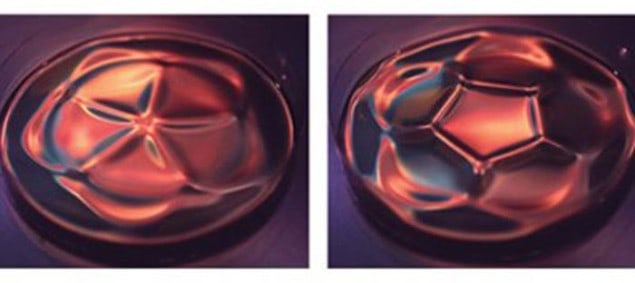
A new wave phenomenon in liquids has been spotted by physicists in France. By shaking small cylindrical dishes of silicone oil, the team created standing waves that spontaneously form a range of patterns, including stars and polygons.
Calculations suggest that the shapes are caused by nonlinear interactions between “gravity waves” – the name given to any fluid wave in which gravity is the dominant restoring force. The researchers hope that their work could lead to a better understanding of other nonlinear gravity waves such as tsunamis and rogue ocean waves.
Gravity waves normally interact in a linear manner – much like light waves – but nonlinear interactions can also play an important role in how they are created and propagate. Indeed, some physicists think that nonlinear effects could be responsible for the giant “rogue” waves that are occasionally created in the Earth’s oceans. To study nonlinear effects, Jean Rajchenbach, Didier Clamond and Alphonse Leroux at the University of Nice looked at gravity waves in silicone oil. Water and oil are both Newtonian fluids, but the latter is easier to work with in the lab because its greater viscosity supports larger-amplitude waves.
Two types of wave
The experiments were carried out in shallow cylindrical dishes that were 9 cm in diameter and filled with 7 mm of oil. The dishes were placed on a vertically vibrating stage and the team could control two parameters: the frequency and amplitude of the vibration. With the frequency set at 8 Hz, the team noticed that, at small amplitudes, waves created at the edge of the container propagate inwards creating ripples that oscillate at the same frequency as the stage.
But as the amplitude was increased beyond about 1.55 mm, however, two counter-propagating waves appeared. These are a “centrifugal” wave that moves outwards from the centre of the dish and a “centripetal” wave that moves inwards from the edge. At relatively low amplitudes this resulted in a standing wave pattern of concentric rings.
Closer inspection revealed that where the crests of the centrifugal and centripetal waves cross, they do not simply superimpose as linear waves do. Instead, the waves experience a phase shift similar to that seen when two plane-wave solitons cross.
Stars and pentagons
As the vibrational amplitude was further increased to about 1.85 mm, five “corners” began to appear in the crest where the two waves cross. This creates a pentagon-shaped crest that breaks the circular symmetry of the dish. Finally, when the amplitude was cranked up to 1.95 mm, the crest oscillated between a pentagon and a five-pointed star with a frequency of 8 Hz (see image). An amazing feature of this oscillating structure is that it does not depend on the shape or size of the container – and even appeared in rectangular-shaped containers.
To understand this bizarre behaviour, the researchers were inspired by theories that describe the formation of quasicrystals in solids and quasipatterns in capillary waves – tiny waves in fluids that are not affected by gravity. They created a theory that, says Clamond, can predict the amplitudes at which the system transforms from one standing-wave configuration to another – but falls short of predicting which shapes the standing wave will assume.
New theory needed
Clamond believes that more work is needed to develop a new theoretical framework for understanding why the shapes form. Indeed, he likens the current situation to when physicists did not have a good theoretical understanding of solitons. But beyond explaining a curious laboratory phenomenon, understanding why the patterns emerge could lead to a better understanding of nonlinear waves in the ocean.
The research is described in Physical Review Letters.



